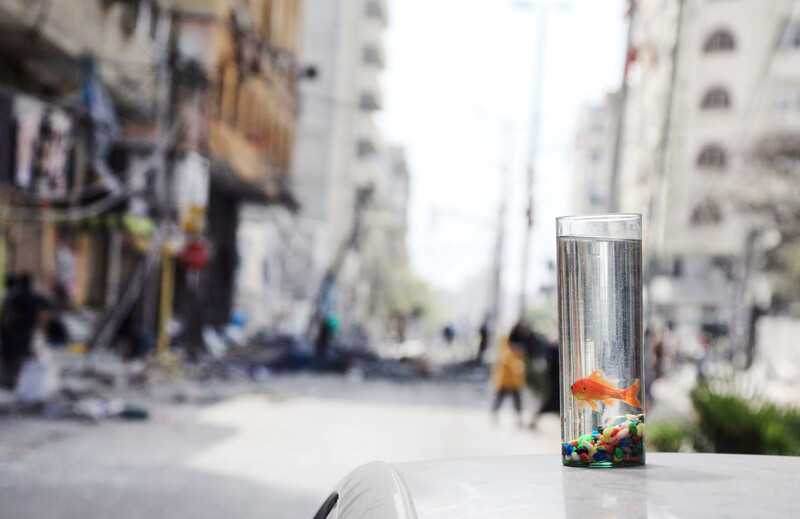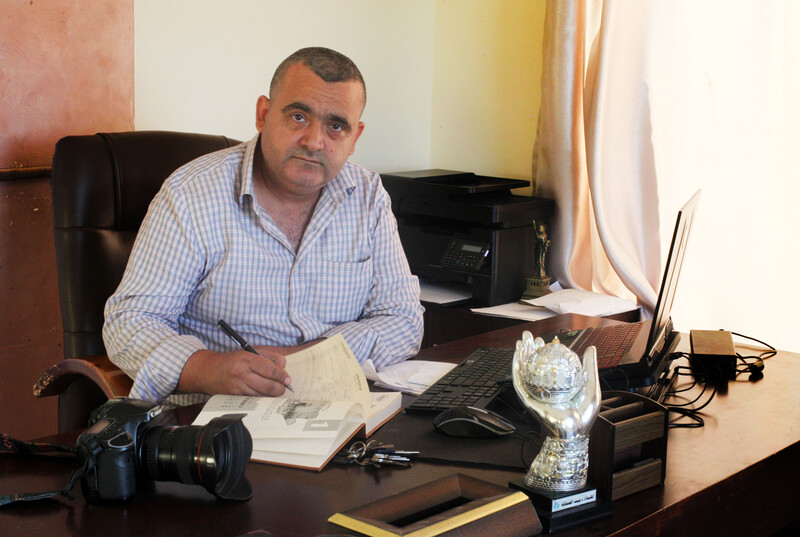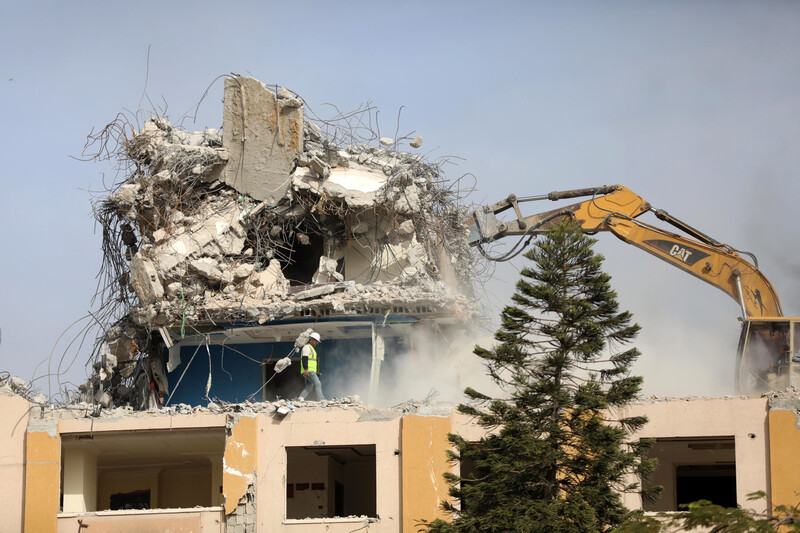The Electronic Intifada 20 September 2022

Naaman Omar’s goldfish survived the carnage.
APA imagesDuring Israel’s assault on Gaza in May 2021, the Israeli military targeted several mixed residential and business high rises in Gaza City that played host to many media outlets.
Among the big media companies that day that lost their offices and equipment were Associated Press and Al Jazeera.
But the greater loss was suffered by many small, independent media outlets with little capital to rebuild.
One of these was APA Images, a local photo agency, which had its offices on the 5th floor of al-Jawhara Tower, one of the high-rises destroyed by Israel’s missiles that May.
Just a few months earlier, in March 2021, Naaman Omar, APA’s founder and director, had spent considerable time refurbishing APA’s offices.
The renovation was a celebration. Omar had finally paid off all debts for the office space, which he now owned. That had seemed the successful culmination of a 13-year journey that began when he and fellow photographer Osama Silwadi started APA during the Israeli attack of December 2008 to January 2009.
He even put an aquarium in the office, complete with a goldfish.
The goldfish, miraculously, survived the bombing.
That fateful day
Monday 10 May was Eid al-Fitr and Omar had brought in sweets for his colleagues. It was also the first day of Israel’s assault. At six am, nine people had been killed in an attack in Beit Hanoun in the northern Gaza Strip.
The next day, Israel destroyed the Hanadi Tower.
“I had a strong feeling that the next target, after the destruction of Hanadi Tower, would be al-Jawhara Tower,” Omar told The Electronic Intifada. “The purpose was to cut off voice, image and word from Gaza to the outside world.”

Naaman Omar
APA imagesOn 11 May at 9 pm a call came to a man living next to the al-Jawhara Tower, Omar said. The call was from an Israeli intelligence officer who ordered him to go and ask the inhabitants of the tower to evacuate.
“At first, I froze,” Omar said. “I couldn’t do anything. But I slowly gathered my wits. The first step was to get everyone out. I felt the weight of responsibility and horror began to creep into me at the thought that someone would be at risk just for being in the office.”
Within minutes, everyone got out of the building. Employees took as much of their equipment as they could carry. Omar parked his car some 150 meters away and sat waiting for the moment his dream and everything he owned would be destroyed.
In the car, he went through all his time at al-Jawhara, “the tape of my memories” slowly unspooling. In the end, he decided to go home.
“I tried to escape to sleep. But I could neither rest nor turn off my mobile so I decided to watch TV, specifically Al Jazeera, whose camera was pointed straight at the tower.”
At two in the morning, Israel bombed the building.
“I had no desire for anything,” Omar said, recalling the impact. “Everything was destroyed. I no longer had any taste for life. Israel destroyed me completely.”
Goldfish from the ashes
As morning came, Omar gathered himself and went to the office. Or what remained. His employees were waiting for him there.
One of them was Yousef Abu Watfa, 34, who had then worked with APA as a photographer for seven years. Some parts of the building still stood he remembered, and would be demolished later.
“I was standing meters away from the APA building. My memories and hopes were destroyed with that building.”
Someone told Omar that the APA office could still be reached relatively safely. He went in to take stock.
Once the shock at the destruction had subsided, Omar grabbed what paperwork could be salvaged. It was then that he noticed the fish.
“When I saw my fish alive, I felt that there was still hope, and that if this fish could survive, so would my company.”
Omar, employees and goldfish all went to the Press House - Palestine, an independent media institution in the center of Gaza City. There they were installed in a temporary headquarters.
“I informed all my clients that I was still working despite the destruction of the company. And within hours we sent out our work as usual.”
Omar and his crew had shown they were still able to work. And two weeks after Israel’s assault ended, they rented a new office in the Shawwa and Hossari Tower.
Everyone was relieved, not least his employees.
“It was very difficult to think that I lost my job, even for a few weeks or months. APA was my only source of income.” Abu Watfa said
A duty to help
In a bid to get APA properly back on its feet, two of APA’s longtime clients, The Electronic Intifada and Mondoweiss partnered with the Middle East Children’s Alliance (MECA) to launch a crowdfunding campaign for APA to purchase new equipment that would be used to conduct training projects for young people in Gaza.
MECA, based in the US, has partnered over many years with Palestinians in Gaza to support emergency relief, development and advocacy, so the organization was well-positioned to work with Omar and his team.
Adam Horowitz, executive editor of Mondoweiss, said it was the least his publication could do to help launch the fundraising effort.
In addition to the value Mondoweiss places on APA’s work, he said, “we also wanted to participate out of an acknowledgment that as a US-based media organization, that it is our country and our government that makes the repeated Israeli assaults on Gaza possible,” Horowitz said.
In an email to readers, The Electronic Intifada’s director Ali Abunimah noted that APA Images had vowed to keep producing photos and videos from Gaza amid the ongoing Israeli bombardment, even though its office had been destroyed.
“They kept their promise. Now it’s our turn,” Abunimah wrote, suggesting that readers donate to the crowdfunding campaign.
Both Mondoweiss and The Electronic Intifada promoted the campaign to their audiences via email and social media.
The funding target of $21,000 was quickly met. APA ran two five-day courses starting in December 2021: one for documentary filmmaking and programming and one for news photography. In all, 12 people, mostly media personnel from local nonprofit organizations, received 25 hours of training, and six new cameras were purchased that will continue to serve journalists in Gaza.

All that remained of al-Jawhara Tower and the offices of APA Images.
APA imagesKholoud al-Zayyan, 26, was among those who attended the photography course. Al-Zayyan works as a media coordinator at Youth Vision Society, a nonprofit focused on supporting Gaza’s youth.
“Photography was always a hobby to me,” she told The Electronic Intifada. “But after I received training, I’ve become more able to do the photography work required for my organization so we won’t have to contract an outside photographer.”
The skills learned, she added, might also help in the future, giving her “more opportunities in the labor market.”
Two APA employees also participated in the training. Abu Watfa wanted to branch out from pure news photography and did the documentary course.
“My skill set has now expanded,” he told The Electronic Intifada. “I have access to more advanced cameras and I’ve developed from a news photographer to a documentary photographer.”
He was, he said, “very grateful” to all those who donated to the APA campaign as was Omar, who said he had “run out of words.”
Now, at least, the journey he started those 13 years ago, when he felt that “there was a tight [outside] censorship of the images coming out of Gaza,” can continue.
Said Horowitz: “Their [APA’s] work is crucially important in telling the Palestinian story to the world, and we wanted to help further that mission if we could.”
For now, APA still operates out of a tiny apartment. But as the work of the Gaza reconstruction committee progresses, Omar is hopeful that APA will soon be fully operational again from its own space.
Then, he said, he wanted to also train new generations of journalists to “get the picture out of Palestine in a complete and humane manner” and to properly portray the Palestinian story abroad.
Sarah Algherbawi is a freelance writer and translator from Gaza.





